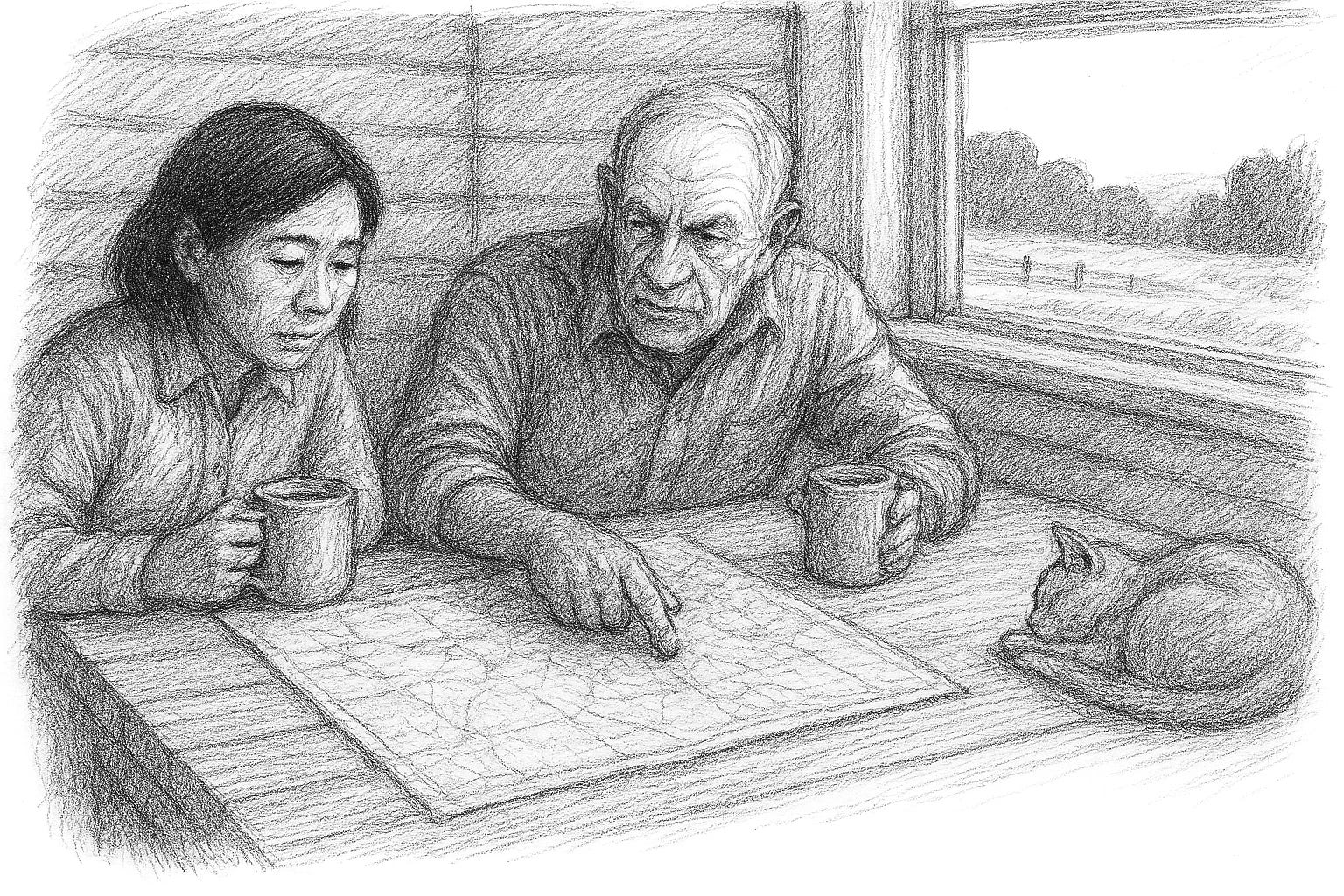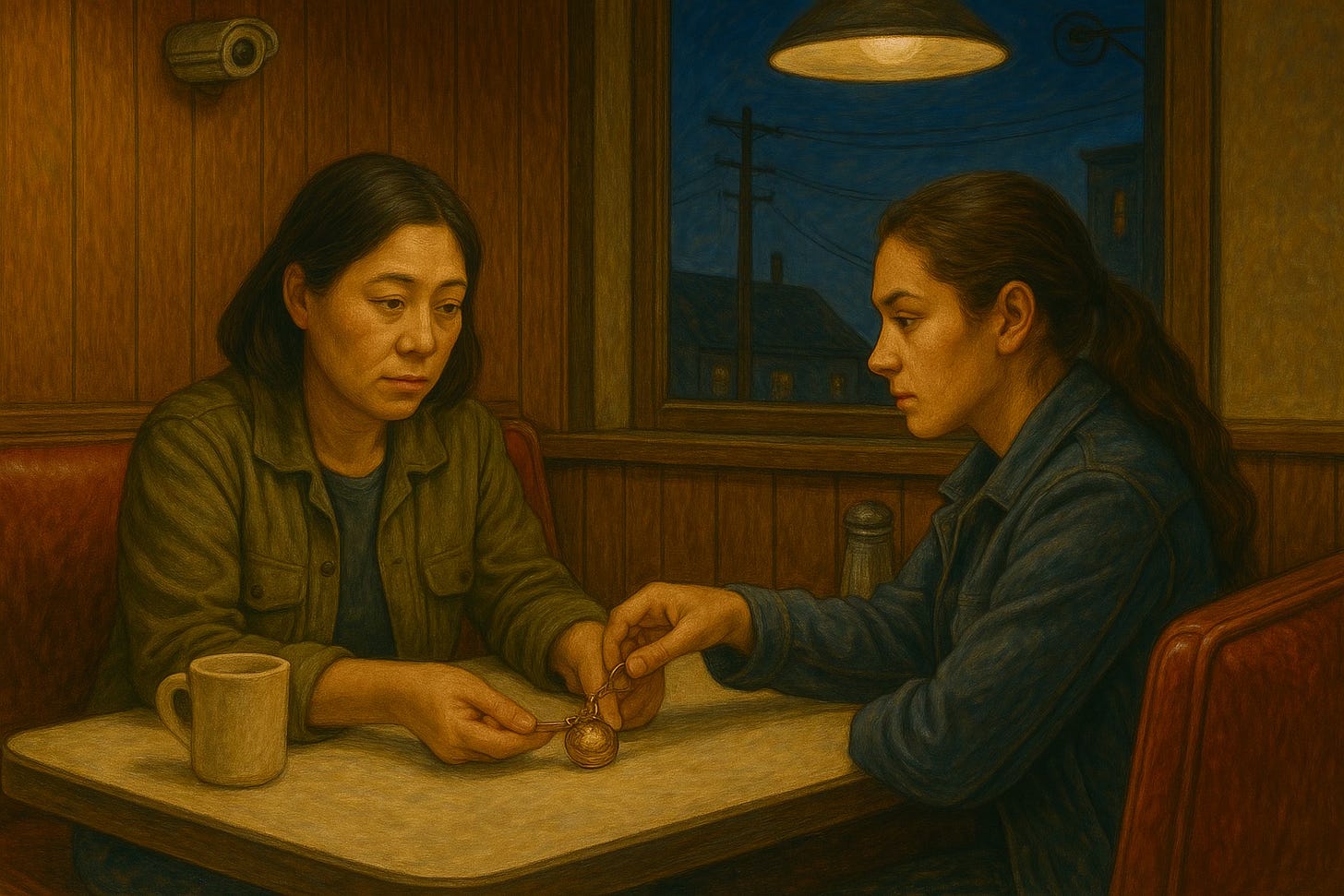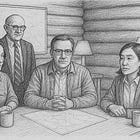Part 2: Finding Others in the Dark
Emily kindles the spark with new-found allies
April 22, 2027 - From the Columbia River Valley
The night rain patters like Morse code on the cabin’s metal roof—an encrypted message from nature I’ve yet to decipher. I’ve moved since my last entry, following a prearranged protocol established months ago when we still believed such precautions might be unnecessary. Paranoia or prudence? In today’s America, the line between them has blurred beyond recognition.
It’s been a week since I witnessed Susan Keller’s arrest for “information crimes”—that surreal moment when ordinary townspeople stood witness, their silent presence more powerful than any protest chant. That moment has stayed with me: Sometimes resistance is nothing more complicated than refusing to look away.
Finding others willing to act requires a delicate dance of trust in a country awash in digital fingerprints. Every credit card transaction maps movement, and facial recognition cameras track public gatherings. How do you build a resistance network when the tools that once connected us are now used to control us?
You begin with what you know. Who you know.
Three days ago, I met with the state’s former public health director, now practicing at a rural clinic under an assumed name. Let’s call her Ruth. When the regime installed healthcare monitors to report “suspicious injuries” and flag dissidents seeking treatment, She quietly disappeared from Seattle, leaving her View Ridge condo and considerable reputation behind. Today she treats patients regardless of their new “citizenship classification”—a social ranking system imposed last year that determines access to everything from healthcare to housing.
“You know I’m not political,” she told me as we walked along a forest trail next to a rushing stream that babbled over our conversation. A precaution against listening devices that might seem paranoid if the former deputy attorney general hadn’t been arrested after his smart speaker recorded a private conversation.
“Neither was I, once,” I replied. We’ve known each other a long time. Raindrops collected on pine needles above us, occasionally letting loose to splatter our shoulders. “But they’ve redefined what ‘political’ means. Treating patients equally is now ‘political.’”
Ruth nodded, her face weathered by more than just Cascadian rain. “I’ve been keeping records,” she said after a long pause. “Deaths that don’t match official causes. Injuries consistent with detention centers. Prescription denials based on classification status.” She met my eyes directly. “Documentation can be resistance, too.”
Documentation. Evidence. Truth. The currency of accountability, assuming we reach that point. I told her about the network I’ve been cultivating—former officials, legal experts, medical professionals like herself—all secretly keeping records that contradict the regime’s sanitized reality.
“It’s not enough, though, is it?” she said. “Taking notes won’t stop what’s happening.”
She’s right, of course. Documentation serves future justice but does little for today’s suffering. Yet what else is there to do when conventional resistance—protests, legal challenges, electoral politics—has been systematically dismantled?
The answer came from an unexpected source.
Yesterday, I met Bill Marshall—a retired Army general living in apparent quiet retirement on his family’s farm. We sat at his kitchen table, drinking coffee from chipped mugs while old barn cats prowled around our feet. Through his window, I watched guys tending fields—except they weren’t just farmhands. I thought I recognized a former Special Forces colonel among them, now sporting a full beard and calloused hands that hadn’t touched a keyboard in months.
“Digital resistance is fine, I guess,” the general said, following my gaze. “But they’ll always have better tech, more resources.” He paused and tapped a hand-drawn map spread between us. “But they can’t be everywhere physically. The country’s too big, too geographically diverse for perfect control. That’s our advantage.”
He showed me what he called “coordination zones”—regions where natural barriers and sparse populations create blind surveillance spots. Areas where “neighbors still know neighbors better than algorithms do,” he said.
“We’re not building an insurgency,” he quickly emphasized, perhaps reading concern on my face. “We’re creating resilience. Communities that can function when systems fail—because they will fail. Regimes always overreach.”
His strategy is deceptively simple: identify essential needs the federal or national systems increasingly can’t or won’t provide, then build alternative networks to meet those needs. Healthcare in rural areas abandoned by corporate providers. Access to food through local agriculture co-ops. Education through informal community schools teaching unchanged history. Each service creates loyalty, each network builds connectivity outside Washington’s control.
“People resist when they believe alternatives exist,” he said. “We need to make those alternatives real.”
Later that evening, I met Sophia Rodriguez at a roadside diner straight out of a Norman Rockwell painting—if Rockwell had included security cameras in his nostalgic Americana. Only 28, Sophia once helped design the very surveillance systems she now works to circumvent. Her expertise makes her both invaluable and vulnerable.
“I built in undocumented back doors,” she said, her voice barely audible above the clatter of plates and country music. “Not for this … nightmare—just standard developer shit. But they’re still there.” She slid a thumb drive across the table, disguised as a cheap tourist keychain. “Old tech. Nothing wireless. Instructions for creating local communication networks that don’t touch standard infrastructure.”
The irony doesn’t escape me: our resistance increasingly relies on technology from decades past. Paper ledgers. Analog radios. Physical dead drops. The digital panopticon has pulled us backward in technological time while pushing us forward in organization.
I am beginning to see what’s emerging. It’s not a traditional resistance movement with headquarters and command structures. Easy targets. Instead, we need to build something more resilient—a network of community hubs, each operating semi-autonomously while keeping loose coordination through careful communication protocols.
We’re not trailblazers here. I’ve been reading about successful historical resistance movements, like the Polish Underground State during Nazi occupation and civil society organizations under the Soviets. The lessons are clear: build dual structures (one visible, one hidden), deliver services to create legitimacy, and establish hard-to-infiltrate trust networks.
With Sophia’s help, I next spoke with James Turner, a mid-level State Department official who happened to be in Brussels when the regime consolidated power. He’s become the unofficial diplomat for what we’ve tentatively begun calling the “Restoration Council.” His charge is to maintain relationships with democratic governments who view the current regime in D.C. with skepticism and alarm.
Sophia helped set up an encrypted video call routed through multiple countries—a risk, but a necessary one given the need for international legitimacy. The choppy video showed a man aged beyond his years, working from what appeared to be a modest apartment filled with donated office equipment.
“The Europeans want to help, but they need a structure to work with,” he said. He chose his words carefully, with diplomatic caution. “They need something that resembles governance—an alternative they can officially recognize when the moment comes.”
I got his meaning immediately. If we wanted international support, we can’t simply oppose the regime—we need to represent a legitimate alternative with clear constitutional standing. We need formal structures, not just networked opposition.
So. All we need to do is build a system of service providers, demonstrate governing capacity, and stay hidden. No problem.
Except, it’s overwhelming. Each person I contact is both an opportunity and a risk. Each location I visit a potential trap. Each conversation might be overheard. The weight of these calculations exhausts me in ways that normal politics never did. Sometimes I wonder if the hardest struggle is just keeping my morale up.
And yet, I’m seeing results from each interaction. Ruth documenting abuses. Bill building community resilience. Sophia creating secure communications. Turner establishing international legitimacy. Each is an essential component of effective resistance—evidence, service, connectivity, recognition.
What gives me hope is not these individual capabilities, but how naturally they’re integrating. Already, Ruth and Sophia are developing plans for secure medical record systems that can track regime abuses while protecting patient identities. Bill sees the potential for distributing these systems through his “coordination zones.” Turner recognizes how such documentation could support our efforts in building international accountability.
We’re growing something organic—a resilient network that doesn’t confront repression directly, but adapts to it. A system designed not for quick victory but sustained resistance. This isn’t the adrenaline-fueled opposition of the movies, but something more sustainable. More strategic.
Tonight, another move. The routine has become familiar: minimal possessions, careful exit routes, countersurveillance measures that would have once seemed absurd for a state governor. I’ll travel to what Bill calls the “Eastern Hub”—a collection of small communities in the Idaho panhandle where federal presence has always been minimal and self-reliance is tradition rather than necessity.
I’m supposed to meet Aiden Murphy, a journalist running an underground information network documenting regime abuses. His reports—distributed through an odd combination of encrypted digital channels and old-fashioned printed pamphlets—have become essential reading for those seeking real news.
As I pack my few belongings, I realize how quickly humans adapt to changed circumstances. A year ago, I was debating infrastructure funding and education policy. Today, I discuss countersurveillance techniques and resistance logistics. But I’m a (former) politician: I’m good at coalition building, strategic planning, stakeholder management. These skills have become more valuable, not less.
I was never particularly ideological. Sure, I didn’t vote for the guy, but that’s how elections go sometimes. Now, though. This is not what America voted for and what sustains me is the conviction that human dignity requires genuine self-determination. We are a flawed people, but Americans deserve a government they choose, not the one imposed upon them. That truth matters, even when inconvenient. That some principles transcend politics.
The rain has stopped, and now I can only hear the faint hoots of distant owl calls. Tomorrow will be challenging, of course—it always is. New challenges, new connections, new risks. But also new possibilities. Each person we bring into the network represents another spark, another point of light that the regime can’t snuff out.
Comments disabled for security reasons. If you're reading this, share it only through secure channels.
Full disclosure and very important
I used AI (Claude, ChatGPT, Gemini) extensively in developing this series. I used it as a research assistant in pulling together the various histories of dissident movements and developing an action plan for the current context. I used it to brainstorm the story arc and plot outline. I even used it as a writing assistant. I didn’t write every word, but I did write a lot of it. As a writer, I have very mixed feelings about this new mode of working, but I think it is the future of AI-assisted writing and research, and the sooner we figure out a way to use it ethically and productively, the better. Part 2




